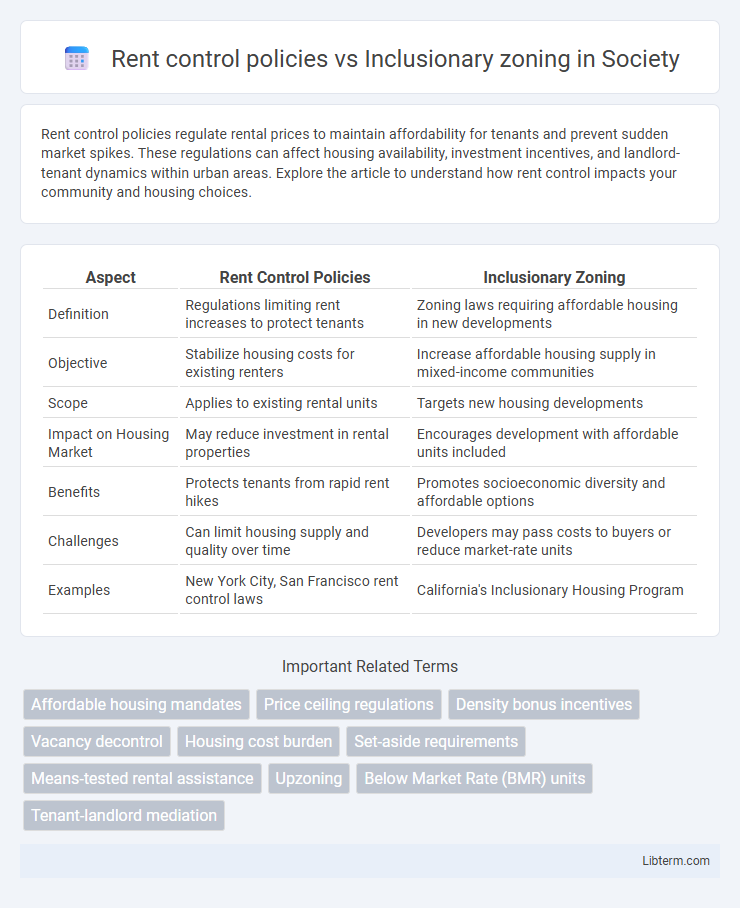Rent control policies regulate rental prices to maintain affordability for tenants and prevent sudden market spikes. These regulations can affect housing availability, investment incentives, and landlord-tenant dynamics within urban areas. Explore the article to understand how rent control impacts your community and housing choices.
Table of Comparison
| Aspect | Rent Control Policies | Inclusionary Zoning |
|---|---|---|
| Definition | Regulations limiting rent increases to protect tenants | Zoning laws requiring affordable housing in new developments |
| Objective | Stabilize housing costs for existing renters | Increase affordable housing supply in mixed-income communities |
| Scope | Applies to existing rental units | Targets new housing developments |
| Impact on Housing Market | May reduce investment in rental properties | Encourages development with affordable units included |
| Benefits | Protects tenants from rapid rent hikes | Promotes socioeconomic diversity and affordable options |
| Challenges | Can limit housing supply and quality over time | Developers may pass costs to buyers or reduce market-rate units |
| Examples | New York City, San Francisco rent control laws | California's Inclusionary Housing Program |
Overview: Rent Control and Inclusionary Zoning Defined
Rent control policies limit the amount landlords can charge for rent, aiming to make housing more affordable and prevent rapid rent increases. Inclusionary zoning requires developers to include a percentage of affordable units in new housing projects, promoting economic diversity within communities. Both strategies address housing affordability but differ in regulatory approach and impact on housing supply.
Historical Context of Housing Policies
Rent control policies originated in the early 20th century, primarily during wartime housing shortages, aimed at stabilizing rents and protecting tenants from sudden price surges. Inclusionary zoning emerged later in the 1970s as a response to growing affordable housing shortages, requiring developers to include a percentage of low-income units in new residential projects. Both policies reflect evolving approaches to housing affordability shaped by economic pressures, urban growth, and social equity concerns.
Key Goals and Objectives of Rent Control
Rent control policies primarily aim to protect tenants from steep rent increases and ensure housing affordability in high-demand rental markets by capping rent prices. These regulations seek to maintain long-term housing stability and prevent displacement of low- and moderate-income residents. Unlike inclusionary zoning, which mandates affordable housing units in new developments, rent control focuses directly on regulating rents in existing rental properties to benefit current tenants.
Core Principles of Inclusionary Zoning
Inclusionary zoning mandates that a percentage of new residential developments be affordable to low- and moderate-income households, promoting economic diversity within communities. Core principles include mandatory or voluntary requirements, on-site or off-site affordable units, and long-term affordability maintenance through deed restrictions or covenants. Unlike rent control policies that cap rental prices, inclusionary zoning encourages the production of affordable housing units tied to new developments, aiming for sustainable integration of affordability in the housing market.
Economic Impacts on Rental Markets
Rent control policies often lead to reduced rental supply as landlords may convert units to non-rental uses or reduce maintenance, causing a decline in overall housing quality. Inclusionary zoning encourages the development of affordable housing by requiring or incentivizing developers to include a percentage of below-market-rate units, which can increase housing supply without distorting market prices. Unlike rent control, inclusionary zoning aims to balance affordability with continued investment in rental development, fostering more sustainable economic outcomes in rental markets.
Effects on Affordable Housing Supply
Rent control policies often limit rent increases, preserving existing affordable housing but may reduce incentives for property maintenance and new construction, potentially shrinking the affordable housing supply over time. Inclusionary zoning mandates a portion of new developments as affordable units, directly increasing affordable housing inventory but may lead to higher market-rate prices due to increased development costs. Both approaches influence affordable housing supply differently, with rent control preserving current units and inclusionary zoning expanding long-term affordable stock.
Policy Implementation Challenges
Rent control policies often face challenges such as reduced housing supply, landlord withdrawal from the rental market, and enforcement complexities that limit their long-term effectiveness. Inclusionary zoning policies encounter obstacles including local opposition, difficulties in setting appropriate affordability thresholds, and ensuring compliance by developers without deterring new construction. Both approaches require careful balancing of regulatory goals with market incentives to achieve sustainable affordable housing outcomes.
Social Equity and Community Outcomes
Rent control policies aim to stabilize housing costs by limiting rent increases, directly benefiting low- and moderate-income tenants and reducing displacement risks in existing communities. Inclusionary zoning requires developers to include a percentage of affordable units in new housing projects, promoting economic integration and long-term affordability in growing neighborhoods. Both strategies impact social equity by increasing housing access, but rent control primarily protects current residents, while inclusionary zoning fosters diverse, sustainable communities through mixed-income housing development.
Case Studies: Successes and Failures
Rent control policies in cities like New York have demonstrated mixed outcomes, stabilizing rents for existing tenants but often discouraging new housing development and reducing overall housing quality. Inclusionary zoning in cities such as San Francisco has successfully increased affordable housing stock by requiring developers to include below-market-rate units, yet critics highlight challenges in implementation and potential market distortions. Comparative case studies reveal that while rent control protects affordability short-term, inclusionary zoning offers more sustainable long-term solutions for diverse communities, contingent on robust policy design and enforcement.
Future Trends in Housing Policy Reform
Future trends in housing policy reform emphasize a balanced approach between rent control policies and inclusionary zoning to address affordability and supply challenges. Rent control limits rent increases to protect tenants from displacement, while inclusionary zoning mandates developers to include affordable units in new projects, promoting mixed-income communities. Emerging reforms prioritize flexible frameworks that integrate data-driven adjustments and incentivize private sector participation to sustainably expand affordable housing options.
Rent control policies Infographic

 libterm.com
libterm.com